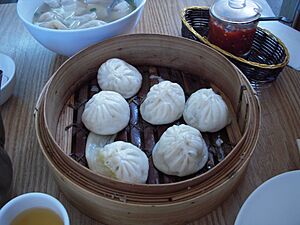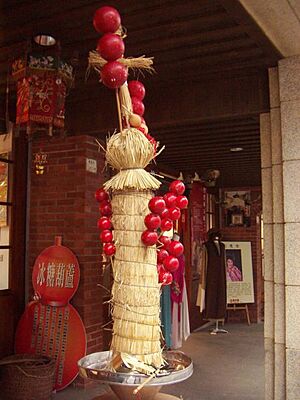Tianjin cuisine facts for kids
Quick facts for kids Tianjin cuisine |
|||||||
|---|---|---|---|---|---|---|---|
| Chinese | 天津菜 | ||||||
|
|||||||
| Jin cuisine | |||||||
| Chinese | 津菜 | ||||||
|
|||||||
Tianjin cuisine, also called Jin cuisine, is the traditional cooking style from Tianjin. This city is the biggest port in Northern China. Tianjin food is a bit like Beijing cuisine, but it uses more seafood. It's known for being fresh, a little salty, and having both soft and crispy textures. Cooks use methods like grilling, simmering, sautéing, and steaming.
Tianjin cuisine has been around for over 300 years. Its history is linked to boatmen and the salt trade because of where the city is located. If you visit Tianjin Food Street, you can find many different Chinese dishes. Some famous foods include Eight Great Bowls, Four Great Stews, Tianjing Goubuli buns, and Four Winter Delicacies. Eight Great Bowls are eight different meat dishes. Four Great Stews include many kinds of stews, like chicken, duck, seafood, beef, and lamb. Tianjin also has many popular snacks. Goubuli (狗不理包子) is a classic steamed bun that is famous all over China. Guifaxiang (桂发祥麻花) is a well-known brand of twisted dough sticks.
Contents
Discover Tianjin Cuisine!
How Tianjin Cuisine Began
Tianjin cuisine officially started in 1662. This was when Ju Qing Xing, one of Tianjin's first famous restaurants, opened. It celebrated the new Kangxi Emperor. In 1860, Tianjin became a "treaty port." This meant foreign businesses and cultures came into the city. Western food was also introduced. A good example is Kiessling's, the first foreign restaurant in Tianjin. A German man named Albert Kiessling started it.
Today, Tianjin food is mostly divided into a few types. These include Han Chinese food, Islamic food, Tianjin vegetarian food, and local snacks.
What Makes Tianjin Food Special?
Seafood and Flavors
One big difference is that Tianjin food uses a lot more seafood. This includes river fish and shrimp. This is because Tianjin is very close to the sea. Both Beijing and Tianjin foods taste salty at first. But Tianjin cuisine also uses sugar, which gives it a special flavor. People trying Tianjin food for the first time will notice a slightly sweet taste mixed with the savory flavor.
Meat and Noodles
Tianjin cuisine also uses more lamb and less pork than Beijing food. For traditional holidays, lamb dishes are a must-have. Also, in Tianjin, vegetables and meat are served separately from noodles. In Beijing, they are often served together.
Finally, Tianjin food has some influences from nearby countries. These include Russia and Japan. Experts believe this is because Tianjin was a treaty port. This made its culture, and its food, more mixed than other big Chinese cities like Beijing.
Famous Food Streets
Nanshi Cuisine Street (南市食品街) is a huge food area in Tianjin's Heping District. It has over 100 restaurants and covers about 40,000 square meters. Some well-known places there include Zheijiang Restaurant and Da Jin Haiwei, which is famous for seafood. There's also Erdouyan Fried Cake Shop. This shop is over 100 years old and known for its rice-powder cakes fried in sesame oil.
Delicious Dishes to Try
| English | Traditional Chinese | Simplified Chinese | Pinyin | Picture | What it is |
|---|---|---|---|---|---|
| Chatang | 茶湯 | 茶汤 | chátāng | Chatang is a traditional Tianjin snack. It's made from baked millet and sticky millet flour. To make the soup, boiling water is poured into the mixed flour. Then, sugar or brown sugar is added. Traditionally, the water comes from a big copper tea kettle with a dragon's head spout. Skilled makers pour the water from high up into your bowl! | |
| Ear-hole fried cake | 耳朵眼炸糕 | 耳朵眼炸糕 | ěrduō yǎn zhá gāo | This is a traditional Tianjin snack. It got its name from a narrow street called Ear-Hole Street. That's where the shop selling it was located. This snack is over 80 years old! A man named Liu Wanchun first sold it from a cart. When his business grew, he opened Liu's Fried Cake Shop. His cakes were high quality, fairly priced, and tasted special. They quickly became very popular. The cake is made from sticky rice dough that is carefully prepared. It's filled with sweet bean paste made from good red beans. The outside of the cake is golden, crisp, and crunchy. The inside is soft and sweet, with a flavor that lasts. | |
| Goubuli baozi | 狗不理包子 | 狗不理包子 | gǒu bù lǐ bāo zǐ | Goubuli Baozi are famous steamed buns from Tianjin. They are stuffed with meat or vegetables. "Goubuli" means "dog doesn't care." This snack was created a long time ago by a man nicknamed "Dog." He started as an apprentice at a bun restaurant when he was 14. Dog was hardworking and honest. He eventually opened his own shop. His buns tasted better and had a special flavor, so more and more customers came. He became so busy that he often didn't have time to talk to customers. People started calling him "Dog doesn't care." So, his buns were named after him! Today, the Goubuli Baozi Shop is a big company. It has 90 restaurants in Tianjin and 24 other Chinese cities. Besides over 90 kinds of buns, their restaurants also offer more than 200 other dishes. | |
| Guobacai | 鍋巴菜 | 锅巴菜 | guōbācài | Guobacai is a snack with a strong local flavor. It's a type of pancake made from millet and mung bean flour. The pancake is cut into thin, noodle-like strips. These are cooked in a sauce made with sesame oil, chopped ginger, soy sauce, preserved beancurd, and green onions. Guobacai is often eaten for breakfast with fried dough and sesame cakes. | |
| Mahua | 麻花 | 麻花 | máhuā | This twisted fried dough might look simple, but it's not easy to make. Each piece is made with good quality flour. Then it's fried in peanut oil. Mahua often has different fillings. The most common is a sweet, waxy sweet bean paste. Mahua can stay fresh for several months. | |
| Tanghulu | 糖葫蘆 | 糖葫芦 | táng húlu | In Tianjin, people often eat Tanghulu on the night before the Lunar New Year. The most popular Tanghulu is made with hawthorn berries. The seeds are removed from the hawthorn berries. Then, they are put on a thin bamboo stick and dipped in hot syrup. When they cool, the berries covered in crystallized sugar look like beautiful, shiny beads. They taste both sweet and sour. Sometimes, the hollowed hawthorn berries are filled with red bean paste, walnut pieces, or melon seeds. Today, you can find many kinds of Tanghulu. Besides hawthorn, there are versions with water chestnuts, tangerines, apples, pears, and crab-apples. | |
| Tianjin preserved vegetable | 天津冬菜 | 天津冬菜 | Tiānjīn dōng cài | This is a type of pickled Chinese cabbage. It's similar to a pickled vegetable from Guizhou cuisine. But Tianjin preserved vegetable takes much longer to make, usually half a year. Also, for this one, the salt pickling and fermentation happen at the same time. The Chinese cabbage is mixed with salt and garlic. Then it ferments, which creates its unique garlic flavor and golden color. To keep its special taste, Tianjin preserved vegetable is often used in soups and fish dishes. It can also be stir-fried and eaten on its own. |






